474th Tactical Fighter Wing
The 474th Tactical Fighter Wing is an inactive United States Air Force unit. Its last assignment was at Nellis Air Force Base, Nevada, where it trained combat-ready aircrews and maintained a rapid-reaction capability to execute fighter attacks against enemy forces and facilities world-wide in time of crisis. During its operational lifetime, the 474th was engaged in combat operations during the Korean War and the Vietnam War. The 474th Wing was inactivated on 30 September 1989.
474th Tactical Fighter Wing
 | |
|---|---|
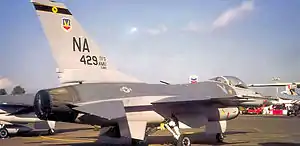 | |
| Active | 1952–1954; 1957–1989 |
| Country | |
| Branch | |
| Role | Fighter, Attack, Interdiction |
| Nickname(s) | F-111A Roadrunners |
| Engagements | Korean War Vietnam War[1] |
| Decorations | Air Force Outstanding Unit Award with Combat "V" Device Air Force Outstanding Unit Award Republic of Korea Presidential Unit Citation Vietnamese Gallantry Cross with Palm[1] |
| Insignia | |
| Patch with 474th Tactical Fighter Wing emblem (approved 14 November 1958)[1] |  |
| Unofficial 474th TFW F-111 Road Runners Patch | 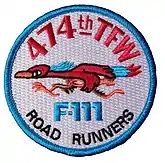 |
History
Korean War F-84E Operations
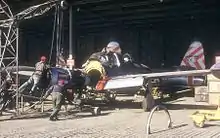
The 474th Fighter Bomber Wing was established on 25 June 1952 assigned to Tactical Air Command (TAC). On 10 July 1952, the wing was activated at Misawa Air Base, Japan, taking over the personnel and F-84G Thunderjets of the 116th Fighter-Bomber Wing. The number '474' recalled the World War II history of the 474th Fighter Group which included the 428th, 429th, and 430th Fighter Squadrons. Corresponding to this legacy, the 474th Wing included, as a component, the 474th Fighter-Bomber Group which included the 428th Fighter-Bomber Squadron, 429th Fighter-Bomber Squadron, and 430th Fighter-Bomber Squadron as combat components. It was assigned to TAC, but attached to 5th Air Force until 1 April 1953 for duty in the Korean War. On 10 July 1952, in what was one of the largest air deployments of its kind, the 474th moved to Kunsan Air Base, Korea on the western side of the Korean peninsula, while the 474th Maintenance Squadron moved to Itazuke Air Base, Japan and integrated into the rear-echelon maintenance combined operations for Thunderjet fighters. Other support units remained at Misawa, attached to the Japan Air Defense Force[2] while the tactical components at Kunsan included the 474th Fighter-Bomber Group.[3]

The 474th Fighter-Bomber Group, as a component of the 474th Fighter-Bomber Wing, initiated combat operations in the Korean War on 1 August 1952. Fighter-bomber operations included night interdiction missions and targeted supply, transportation, and troop concentrations. Specific accomplishments included devastating strikes against troop concentrations near Pyongyang, disruption of a MiG attack, and major strikes against a munitions factory and destruction of a political/military instruction center. Missions included night interdiction missions against supplies and lines of communications, escorting Douglas B-26 Invaders on bombing operations in MiG Alley; air defense suppression; armed reconnaissance; and strafing and bombing troops in trenches, bunkers, and shelters, and heavy weapons positions. In January 1953 targeting shifted to communications, training complexes, and rebuilt North Korean assets, including: the Sinanju rail facilities, the Kyomipo industrial area, the Pyongyang Tank and Infantry School, the munitions processing plant near Sunchon, and enemy troop concentrations near Wonsan.[4]
On 1 April 1953, the 474th Fighter-Bomber Wing was attached to the 58th Fighter-Bomber Wing. As part of the move, the 474th Fighter Bomber Group was detached from the 474th FBW and assumed the personnel and equipment of the 49th Fighter-Bomber Group at Taegu. It was attached to the 58th Fighter-Bomber Wing as a reinforced wing, and the 474th Fighter Bomber Wing was reduced to paper status. The 474th FBW was subsequently inactivated on 8 November 1954. This made the 58th the largest fighter-bomber wing in Korea.[5] Only the 430th Squadron actually moved to Taegu.[6][7] With the coming of spring the 474th contributed significantly to Operation Spring Thaw, a Fifth Air Force program to disrupt communist efforts to move supplies to the front in bad weather. The 474th FBG knocked out supply lines and inhibited their repair. During peak efforts, the 474th FBG pilots often flew four or five missions per day. The 474th Fighter Bomber Group participated in a total of 2207 close support strike. The 474th FBG participated in the destruction of North Korean airfields to prevent a last minute influx of enemy planes and material. "On 22 July 1953, in one mission led by Lt. Col. Douglas Montgomery, who was then executive officer of the 474th FBG, 30 out of a total of 40 bombs were placed along the entire length of a runway at the airfield at Sunchon."[8] On the 27 July, just prior to the signing of the truce, the 474th attacked Chunggangjin Airfield in what was one of the last and one of the deepest penetrations of the War. When hostilities stopped, the Armed Forces Assistance to Korea program was launched and the men of the 474th FBG volunteered their off-duty time to work with local villagers in constructing and replenishing a new school building.[6][7]
Korean War Era Commander
- Colonel William W. Ingenhutt, 10 July 1952 - 31 March 1953
Korean War Era Campaigns
- Korea Summer-Fall, 1952
- Third Korean Winter
- Korea Summer-Fall, 1953[9]
Cold War F-86H and F-100D Operations
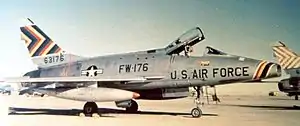
The wing was activated at Cannon Air Force Base on 8 October 1957, replacing the 474th Group. It maintained proficiency in tactical fighter operations, deploying components, aircraft, and crews on a global basis in support of NATO, Pacific Air Forces, Alaskan Air Command, and other organizations while flying the North American F-100D Super Sabre. The 474th deployed three squadrons (44 aircraft) to Homestead Air Force Base Florida during the Cuban Missile Crisis on 24 October 1962 as part of the Air Division, Provisional, 1st under Brig. Gen. Gordon M. Graham. The entire wing, except for a deployed squadron in Southeast Asia, reverted to paper status on 15 September 1965, and the detached squadron was reduced to paper status upon its return to the United States. The 429th Squadron had been deployed with the F-100D to Bien Hoa Air Base, South Vietnam with the 3rd Tactical Fighter Wing on 13 July 1965. The Squadron flew 1627 missions before its return to the U.S. It returned to the U.S. to be inactivated on 16 December 1965.[10]
F-111A operations

The 474th (Roadrunners[11]) became the first USAF operational wing equipped with the General Dynamics F-111.[12] On 20 January 1968 the 474th Tactical Fighter Wing was activated at Nellis Air Force Base, Nevada replacing MAJCON 4480th Tactical Fighter Wing, which had been activated on 15 July 1967,[13] giving the base an operational tactical fighter wing assigned to Twelfth Air Force. With the wing, the 428th Tactical Fighter Squadron (Tail Code NA - blue stripe) replaced the 4481st Tactical Fighter Squadron and the existing 429th Tactical Fighter Squadron (Tail Code NB - yellow stripe) was assigned.
In January 1968 the 428th Tactical Fighter Squadron, Detachment 1 received the first 6 of 9 "Harvest Reaper" aircraft [66016, 66017, 66018, 66019, 66020, 66021, 66022, 66024, 66025]: F-111As with the unique camouflage paint job and upgraded avionics (including the ballistics computer unit and fittings for external noise jammers) in preparation for combat evaluation.[14] With the move to Nellis, the 474th Combat Support Group became the base operating host unit.[13] The 428th Squadron reached an initial operational capability in the spring of 1968.[12] In December 1968, Tactical Air Command activated the 4527th Combat Crew Training Squadron (Tail Code ND - green stripe) as a dedicated F-111 pilot training squadron at Nellis. The squadron performed lead-in training for experienced pilots in the F-111. It was replaced in October 1969, transferring its personnel and equipment to the newly activated 442nd Tactical Fighter Training Squadron.[15] On 15 September 1968 the 430th Tactical Fighter Squadron (Tail Code NC - red stripe) became part of the Wing.
In early 1968, the Air Force decided to send a small detachment of F-111As to Southeast Asia under the Combat Lancer program using the six 428th Squadron Harvest Reaper F-111As that were allocated to Combat Lancer as Detachment 1[16] under the command of Colonel Ivan H. Dethman, and they departed Nellis for Takhli Royal Thai Air Force Base on 15 March 1968. The six F-111s, accompanied by Boeing KC-135 Stratotanker tankers, departed for Andersen Air Force Base, Guam. The over 13 hour trip was flown using the F-111's inertial navigation system and with topoff refueling from the tankers, arriving at Andersen on the 16th.[17] The Detachment departed Andersen and arrived at Takhli on 17 March. The detachment was attached to the Republic F-105 Thunderchief-flying 355th Tactical Fighter Wing in what was seen as the first stage in replacement of the 355th Wing's F-105s with the F-111A.[18] F-111 combat operations began on 25 March using the aircraft's unique terrain following radar capability to conduct surprise night deep air interdiction strikes.[19] By the end of the deployment, 55 night low-level missions had been flown against targets in North Vietnam, but three aircraft had been lost. Aircraft 66022, call sign Omaha 77, had been lost on 28 March with the loss of the crew, Colonel Hank McCann and Captain Dennis Graham. On 30 March, the crew of Major Sandy Marquardt and Captain Joe Hodges in aircraft 66017, Hotrod 73, successfully ejected and was recovered uninjured in Thailand.[20] Replacement aircraft had left Nellis, but a third loss halted F-111A combat operations. On 22 April, Tailbone 78, aircraft 66024, crewed by Lieutenant Commander Spade Cooley and by Lieutenant Colonel Ed Palmgren, was lost.[21] After the 3rd loss, the Detachment remained poised for combat, but they saw no combat action before their return to the U.S. on 22 November.[12]
The causes of first and third losses continues to be unknown as the wreckage have not been recovered, but there was very little evidence the losses were due to enemy action. The loss on 30 March was not due to enemy action, but was traced to a failure of a hydraulic control-valve rod for the horizontal stabilizer which caused the aircraft to pitch up uncontrollably. Further inspection of the remaining fleet of F-111As revealed 42 aircraft with the same potential failures.[22] It is speculated that this failure could also have contributed to the two other losses had the failure caused a pitch down while at low altitude. These losses caused a storm of controversy in the United States, with Wisconsin Senator William Proxmire denouncing the F-111A as an unsafe and defective plane. However, the Air Force and General Dynamics continued to work hard trying to fix the problems with the F-111A. Modifications to the F-111 took longer than expected, and the wing was not fully operational until July 1971.[12] In September 1971 the Wing started receiving "new" pilot weapon systems operators (PWSO) directly from graduating pilot training classes, providing a basis for future F-111 experienced aircraft commanders throughout the F-111 fleets worldwide. The Combat Lancer deployment had included right seat pilot weapon system operators, but these were previously fully-qualified F-4 pilots who were "unhappily conscripted" for the position.[23] After July 1971, the 474th gradually assumed additional operational responsibilities and the various squadrons "certified" crews on a variety of world-wide targets in support of potential wartime scenarios, including targets in Cuba and the Eastern Bloc. During this period, training became very safety oriented and the wing restricted TFR night flight to visual flight rules conditions at a minimum altitude of 1000 feet above ground level, typically flown at 480 knots true airspeed. Multiple low-level routes had been established throughout the western U.S., and these became the primary routes for training and practice bombing on the Nellis Range, Holbrook, Arizona Radar Bomb Site, and other bombing and electronic warfare ranges in the west. These training practices would later prove to be inadequate in the high-threat environment and varied and sometimes extreme terrain and intense rain conditions of North Vietnam and Laos.
On 14 August 1972 the Air Force issued a deployment "frag order" for the 474th.[24] The 474th returned to Takhli in September 1972 with the Constant Guard V deployment of the 429th and 430th Squadron with 48 F-111As under the command of Wing Commander Colonel William R. Nelson.[25] The deployment included 1,487 support personnel and 40 transport aircraft loads of cargo.[26] The enhanced strike capabilities of the two F-111 squadrons (48 aircraft) allowed them to replace the four F-4D squadrons (72 aircraft) of the 49 TFW, which returned to the U.S. This move also resulted in a reduction of total U.S. forces stationed in Thailand.[26] The two F-111A squadrons arrived to support the last month of Operation Linebacker and all of the Operation Linebacker II bombing offensive against North Vietnam, conducted combat operations in Laos including support of Operation Phou Phiang II and Operation Phou Phiang III using the F-111A's beacon bombing capability in the defense of Long Tieng, and conducted combat operations in Cambodia, again using the F-111's beacon bombing capability.
An integral part of the concept of operations for the Constant Guard V deployment was to demonstrate a minimal time (less than 24 hours) from the deployment of the F-111 until the first F-111 combat operations. Twelve 429th F-111s departed Nellis on 27 September, arriving at Andersen Air Force Base, Guam on 28 September. After a 3-hour fueling stop, they departed Andersen on 28 September, using prepositioned fresh crews, and arrived at Takhli that day. Lieutenant Colonel Mat Mathiasen, commander of the 429th TFS flew the first F-111A (67086) into Takhli.[27] Flight crews had been prepositioned by C-141 Starlifter at Takhli. The crews included 429th and 430th Squadron personnel who had already mission planned to fly the first strikes against North Vietnam. An additional 12 429th F-111s departed Nellis on 27 September arriving at Hickam Air Force Base Hawaii the same day. They departed on 28 September arriving at Clark Air Base Philippines on 29 September. They departed Clark on 30 September arriving at Takhli on the same Day. On 29 September, 24 F-111s of the 430th, led by the squadron commander Gene Martin, left Nellis for Hickam. They departed Hickam on 30 September, arriving at Clark on 1 October. Because of complications for movement of units and supplies due to tropical storm Kathy, the 430th was unable to depart Clark for Takhli until 4 October, arriving at Takhli the same day.[28]
Unlike the phased approach used by the other combat aircraft where the first 10 missions were to be flown in the lower threat areas of North Vietnam (Route Packages 1-4), The first F-111s were immediately assigned missions in Route Package 5. The initial sorties against North Vietnam were launched the same day (within 3–4 hours) of the arrival on 28 September (Thailand time) of the first aircraft from Nellis. The mission for the F-111 was unique in that the crew was given a weapons load, intended target, and time on target. Everything else in terms of mission planning was left to the flight crew, including ingress, target area, and egress tactics, route, and deconfliction with other F-111s which may fly similar routes or hit nearby targets. The missions were planned without RB-66E electronic countermeasures escort aircraft, air defense suppression aircraft, MiG Cap, or Boeing KC-135 Stratotankers. Tactics were all night low-level using TFR and intended for deep strikes to support Operation Linebacker. Airspeed was generally no less than 480 knots, with many crews using 510 or 540 KTAS in the high-threat environment prior to weapons delivery. The development of high-drag weapons had not kept up with the development of the F-111 as a platform to deliver those weapons. As a result, the F-111 was forced to decrease its speed to 500 KTAS for the release of high-drag bombs at low altitude to preclude ripping the fins off the bombs. TFR altitude was generally tied to the threat level, starting at 1000 feet AGL and descending to as low as 200 feet in the high-threat environment. Altitude was typically inversely related to the Radar Homing and Warning System indications from SAM sites - the more threatening the signal the lower the TFR altitude. Egress speeds were generally limited to high sub-sonic speeds at TFR altitudes to avoid the use of afterburner which could light up the aircraft and provide a visual target for ground gunners. Restricting the F-111 to military power, however, did not prevent low altitude egress speeds from occasionally exceeding 660 KTAS. On climb out, once clear of the high-threat area, crews often accelerated to 1.3 mach - the limiting speed on the external ALQ-87 jammer pods - once it was confirmed that there were no hung bombs (bombs that failed to release). Initially, bomb loads for low-altitude deliveries included 12 Mk-82 High Drag (HD) 500 pound bombs for level delivery or 4 Mk-84 2000 pound slick bombs using a stabilized climb. After the first 2 aircraft losses, low-altitude bomb deliveries were generally restricted to 12 Mk-82 HDs. The first loss occurred on the first night, Ranger 23, aircraft 67078, flown by Major Bill Coltman (a Combat Lancer veteran) and 1st Lieutenant Lefty Brett of the 430th TFS. The wreckage was discovered in Laos and remains were identified on 12/19/2001.[29] Following the loss, F-111 combat operations were paused to allow for a maintenance shakedown of all of the aircraft and to allow for a local area orientation and review of tactics for the crews. Immediately following the loss, a Search and Rescue (SAR) effort was initated covering approximately 8400 square miles of Laos and North Vietnam, to no avail. It was terminated on 10 October. F-111 combat operations were reinitiated on 5 October against Linebacker targets (lines of communication, rail yards, marshalling and supply areas, and other targets) using the modified low-level tactics.[30] Crews were given one mission in the RP1-4 regions and one mission in the RP-5 region prior to missions in RP-6 to build confidence and experience. The second aircraft loss occurred on 16 October - Coach 33, flown by Captain Jim Hockridge and 1st Lieutenant Al Graham of the 429th TFS, in aircraft 67060. The North Vietnamese claimed the shootdown and presented the aircrew's ID cards. The weapons load was 4 Mk-84 2000 pound bombs. A thorough SAR effort was conducted following the loss, again to no avail. The aircraft wreckage and remains were identified on 25 October 1977.[29] Following the loss, another reevaluation of tactics occurred and the use of "slick" bombs in low-altitude deliveries was terminated except for in extraordinary situations. F-111 night low-level strikes continued against North Vietnam until President Nixon ordered the cessation of strikes north of the 20th parallel on 23 October. These F-111 strikes to date demonstrated that the North Vietnamese surface-to-air missiles (SAMs) and MiGs were ineffective in countering the low-level F-111A, and the North Vietnamese focused more on the use of anti-aircraft artillery (AAA) against the F-111.[31]
Following the 23 October bombing halt and until the initiation of Linebacker II operations on 18 December, F-111 operations focused on the southern portions of North Vietnam in Route Pac 1 (RP1) again using low-level night tactics, and on Laos. The operations in RP1 were against lines of communications, storage areas, air defenses, and other targets. There were 402 sorties flow in RP1 in November.[32] The third loss occurred on 7 November. Major Bob Brown and Major Bob Morrisey of the 430th TFS, Whaler 57, flying 67063, were lost on a night low-level mission.[33] The wreckage was later found on 3 July 1992.[34] On 8 November 1972, the F-111s flew 20 strikes over North Vietnam in weather that grounded other aircraft. The fourth loss occurred on 20 November. Aircraft 67092 was flown by Captain Bob Stafford and Captain Chuck Caffarelli of the 430th TFS, Burger 54, again flying a night low-level mission and using a "feet wet" egress over the South China Sea. Wreckage of this aircraft washed onshore in South Vietnam, indicating aircraft impact with the sea with wings swept to 72 degrees and no indication of crew ejection.[35]
On 21 October 1972 Col. Bill Nelson, wing commander, received a request from the Ambassador of Laos to send an F-111A crew to Vientiane Laos to meet with the Ambassador's air attache. The crew, Colonel Bob Anderson and Major Harry Richard, was briefed on the upcoming North Vietnam Army (NVA) offensive against Skyline Ridge which overlooks Long Tieng and inquired if the F-111 had the capability to support the ongoing Operation Phou Phiang II to counter the North Vietnamese Army (NVA). The answer to the question added a new dimension to F-111 operations with the use of the AN/PPN-18 Radar Beacon for offset bombing in support of friendly forces. This represented a major departure from the initial concept of employment for the aircraft. Radar beacons were deployed under Operation Sentinel Lock at key mountain top locations and used as offset aiming points for medium altitude delivery of 24 MK-82 500 pound bombs or 16 CBU-52 or CBU-58. This technique enabled the F-111 to strike targets developed by Raven FACs, Forward Air Guides, or ground commanders, regardless of day/night or weather conditions, occasionally within 200 meters of friendly forces. Beacons allowed a flexibility to strike preplanned fixed targets or, unique to the F-111, be diverted to real-time high-priority targets in support of troops in contact. Additionally, when weather hindered other aircraft from striking their targets, the F-111 would be used as a pathfinder to guide accompanying F-4 and A-7 aircraft to area targets and provide the bomb release signal. The first successful F-111 beacon bombing mission was flown on 11 November 1972. In an excerpt from a letter by General Vang Pao, Commanding General of Military Region II to the Commander, 474th TFW, “Prior to your arrival in MR II, the enemy had plans and high hopes for offensives against Long Tieng. The F-111, WHISPERING DEATH as it is called, has changed all of that…..your bombs, falling in inclement weather and at all hours of the night have had telling effect on the moral of the North Vietnamese 316th Division. Where once he was making plans to attack, he is now feverishly trying to avoid destruction from the sky.” In December alone, the F-111 flew 522 sorties in Laos, the most of any U.S. aircraft type. The successful beacon bombing program was greatly expanded to include beacons compatible with B-52s being placed alongside those being used by the F-111. The F-111s continued beacon bombing strikes supporting Operation Phou Phiang III, 18 January - March 1973. By the end of the Laos conflict on April 17, 1973, 2392 F-111 sorties had been flown using 7 beacon locations with 91% effectiveness. The last sorties against Laos were flown on 15–17 April, 40 by B-52s and 24 by the F-111s.[36]
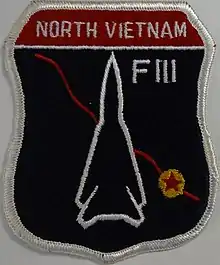
During Linebacker II, 18 December 1972 - 29 December 1972, the F-111 flew 154 low-level night missions against critical targets in the high-threat air defense environment of Route Pac 6 with two aircraft losses. The Linebacker II operations were flown while the F-111 continued to conduct beacon bombing operations in Laos. The Linebacker II targets included SAM sites, airfields, rail yards, storage areas, lines of communications, and other targets. The next loss occurred on the first night of Linebacker II, on 18 December. Snub 40, aircraft 67099, was flown by Lieutenant Colonel Ron Ward and Lieutenant Colonel Jim McElvain of the 430th TFS. The crew had called off target and had planned to go "feet wet" over the Tonkin Gulf.[37] The aircraft disappeared soon after going feet wet and wreckage and remains have never been recovered. The 6th and final F-111A combat loss occurred on 22 December. Jackal 33, aircraft 67068, flown by Captain Bob Sponeybarger and 1st Lieutenant Bill Wilson of the 429th TFS, ejected successfully after being hit by ground fire near Hanoi. Captain Sponeybarger was captured after 3 days and Lieutenant Wilson spent a week in escape and evasion (E&E) before being captured.[38] Both were repatriated on 29 March 1973 after serving time as POWs. The Paris Peace Talks, on 23 January 1973, resulted in an agreement to terminate all U.S. combat operations against North Vietnam effective 28 January 1973 Saigon time. On 15 January the USAF restricted all air strikes on North Vietnam to south of the 20th parallel. The last U.S. air strikes on North Vietnam occurred on 27 January.[39] The 429th and 430th TFS flew slightly more than 4000 combat missions between late September 1972 and mid-March 1973 with excellent success rates in hitting targets even when visibility was near zero. A total of six aircraft were lost in action.[12] The loss rate was assessed to be "remarkably similar" to that of the Navy A-6 and Air Force F-105 when flying night terrain-following operations.[40] The 474th was awarded the Air Force Outstanding Unit Award with Combat "V" Device 28 Sep 1972-22 Feb 1973[41] and Republic of Vietnam Gallantry Cross with Palm 28 Sep 1972-22 Feb 1973.[42]
The 429th and 430th and, later, the 428th (which replaced the 430th TFS on 22 March 1973) also flew bombing missions against targets in Laos and Cambodia in the midst of the monsoon season. In March 1973 the USAF started inserting 10 beacons in Cambodia. The F-111s again demonstrated they could bomb through an overcast as close as 200 meters from friendly forces. This capability saved Neak Luong from being overrun by enemy forces. On 20 March 1973, Lieutenant Colonel Gene Martin, 430th TFS Commander, and Major Bill young flew the last combat sortie by the 430th. The 428th and 429th continued to conduct beacon bombing and Pathfinder operations in Cambodia as part of the 474th until 30 July 1973.[43] On 7 June 1973 Captain Chris Russo and 1st Lieutenant Chuck Foster of the 429th TFS were the first F-111 crew to fly 100 combat missions in the F-111.[44]
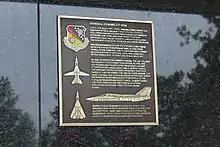
On 23 June 2017 a bronze plaque was dedicated to the 474th TFW organization and the F-111A crews at the Southeast Asia Memorial Pavilion[46] at the United States Air Force Academy. The plaque hangs in honor of the bravery and dedication of all who supported and participated in the 474th TFW F-111A combat operations in Southeast Asia in 1968 and 1972-1973.[47]
The 430th returned to the 474th Wing at Nellis on 22 March 1973 assuming a replacement training unit mission, while the 428th and 429th were assigned to the newly transferred 347th Tactical Fighter Wing at Mountain Home Air Force Base, Idaho on 30 July 1973 (deployed to Takhli Royal Thai Air Force Base). The 347th's F-111s continued to support combat operations in Cambodia until all U.S. air strikes terminated on 15 August 1973. With the end of hostilities in Southeast Asia and the 474th's return to Nellis, its mission was again to train combat-ready forces of aircrews and maintain a rapid-reaction capability to execute fighter attacks against enemy forces and facilities in time of crisis.[12]
On 19 July 1975 the Constant Guard V deployment was completed and the 428th and 429th were reassigned to the 474th TFW, Nellis AFB. The last operational F-111As left Nellis for Mountain Home Air Force Base on 2 August 1977 and Colonel Mo Seaver relinquished control of the 474th to Colonel Reginald Davis on 5 August as the F-111 aircraft and crews were transferred to the 366th Tactical Fighter Wing as part of Operation Ready Switch.[13] The F-111A wing left behind at Nellis 3 "hanger queens" that needed maintenance and Functional Check Flights (FCFs), tail numbers 67056, 67038, and 67102. These were accomplished and the last 474th TFW F-111A to leave Nellis AFB was 67102, flown on 9 August 1977 to McClellan AFB for overhaul by F-111A FCF Pilot Captain Roger (Pete) Peterson and an Australian Air Force exchange Weapon System Operator.
F-4D and F-16A/B operations
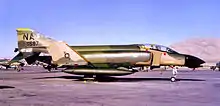
The 474th Wing absorbed the McDonnell F-4 Phantom II aircraft, crews, and resources of the inactivating 4474th Tactical Fighter Wing, which had been activated on 1 March 1977 at Nellis on 5 August 1977, as part of Operation Ready Switch.[13] The 48th Tactical Fighter Wing F-4D Phantoms had been rotated from Lakenheath Air Base in Europe in order for the F-111Fs, previously stationed at Mt. Home AFB, to be stationed at Lakenheath Air Base to give USAF assets in Europe a greater range, weapons carriage, and all-weather capable strike capability. With the transfer of the F-4D from Lakenheath to Nellis, Chesley Burnett Sullenberger III (Sully) was then assigned to the 428th TFS where he attained the rank of captain and served as a flight lead, training officer, and Operation Red Flag Blue Force Mission Commander. The F-4D had a relatively short life, being replaced with new General Dynamics F-16A Fighting Falcons. The 474th was the third USAF wing to receive Fighting Falcons. It received its first Block 1/5 F-16A/Bs in November 1980, later operated Block 10 F-16A/Bs.[12][48]
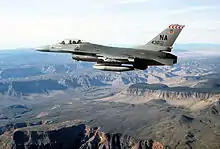
The wing conducted routine Tactical Air Command training and deployments from Nellis with the F-16s, retaining the Block 10/15 models until September 1989, when the wing was inactivated, the F-16As no longer being considered as front-line aircraft. Instead of re-equipping the wing, the F-16As were transferred to Air National Guard and Air Force Reserve squadrons, and the three squadrons resurfacing as General Dynamics-Grumman EF-111A Raven Electronic Warfare Squadrons with the 27th Operations Group (27th Tactical Fighter Wing) at Cannon Air Force Base, New Mexico.[13]
Lineage
- Established as the 474th Fighter Bomber Wing on 25 June 1952
- Activated on 10 July 1952
- Inactivated on 8 November 1954
- ctivated on 8 October 1957
- Redesignated 474th Tactical Fighter Wing on 1 July 1958[49]
- Inactivated on 30 September 1989
Assignments
- Tactical Air Command, 10 July 1952 – 8 November 1954 (attached to 58th Fighter-Bomber Wing after 1 April 1953)[50]
- 832d Air Division, 8 October 1957
- USAF Tactical Fighter Weapons Center, 20 January 1968
- 832d Air Division, 20 March 1968 (attached to Seventh Air Force, Advanced Echelon (ADVON), c. 27 Sep 1972 – c. 23 March 1973)
- Twelfth Air Force, 1 July 1975 – 30 September 1989[51]
Components
- 474th Fighter-Bomber Group: 10 July 1952 – 8 November 1954
- 428th Fighter-Bomber Squadron (later 428th Tactical Fighter Squadron): 8 October 1957 – 30 July 1973; 15 June 1975 – 30 September 1989
- 429th Fighter-Bomber Squadron (later 429th Tactical Fighter Squadron): 8 October 1957 – 30 July 1973; 21 June 1975 – 30 September 1989
- 430th Fighter-Bomber Squadron (later 430th Tactical Fighter Squadron): 8 October 1957 – 15 November 1966; 15 September 1968 – 30 September 1989
- 442nd Tactical Fighter Training Squadron: 15 October 1969 – 31 July 1977
- 478th Fighter-Bomber Squadron (later 478th Tactical Fighter Squadron): 8 October 1957 – 1 November 1966 (often detached)[49]
- 4474th Tactical Training Squadron, 1 December 1968 – 15 June 1970 (not operational)
- 4527th Combat Crew Training Squadron, 20 January 1968 – 15 October 1969[49]
Stations
Aircraft
- Republic F-84E Thunderjet, 1952–1953
- F-100D Super Sabre, 1957–1965
- General Dynamics F-111A, 1968–1977[49]
- McDonnell F-4D Phantom II, 1977–1981
- General Dynamics F-16 Fighting Falcon, 1981–1989
Commanders
- Col. William W. Ingenhutt, 10 July 1952-1 April 1953
- Col Franklin H. Scott, 8 Oct 1957
- Lt Col Jake L. Wilk, Jr., 15 Jul 1958
- Col Thomas D. Robertson, 19 Jul 1958
- Col William L. Curry, 8 Aug 1958
- Col Gust Askounis, 30 Jul 1960
- Col William L. Mitchell, Jr., 18 Aug 1960
- Col Niven K. Cranfill, 6 Jun 1962
- Col Francis E. Binnell, 21 Aug 1964
- Col Paul P. Douglas, Jr., 3 Sep 1964
- Lt Col Benjamin H. Clayton, 14 Jul 1965
- Col Oscar L. Watson, 28 Aug 1965
- 1Lt Robert R. De Cocco, 15 Sep 1965 (additional duty)
- Col Ivan H. Dethman, 1 Oct 1966 - 9 Aug 1967
- LtC Maurice A. Spenney, 9 Aug 1967 - Unk
- Col Chester L. Van Etten, 20 Jan 1968 - 11 Jun 1969
- Col Carmen M. Shook, 20 Jun 1968 - 5 Jun 1969
- Col Frederick C. Blesse, 5 Jun 1969 - 26 Jun 1970
- Col Herbert L. Gavin, 26 Jun 1970 - 22 Jun 1971
- Col Kenneth P. Miles, 22 Jun 1971 - 1 Aug 1972
- Col William R. Nelson, 1 Aug 1972 - 25 Jul 1973
- Col James N. McClelland, 25 Jul 1973 - 28 Feb 1975
- Col Thomas E. Wolters, 28 Feb 1975 - 24 May 1976
- Col Maurice E. Seaver Jr., 24 May 1976 - 5 Aug 1977
- Col Reginald Davis, 5 August 1977 - Unk
- Col Donald L. Miller, unk - 1 May 1979
- Col James B. Davis, May 1979 - May 1980
- Col Charles A. Horner, May 1980 - August 1981
References
Notes
- Explanatory notes
- Aircraft is General Dynamics F-16A Block 10A serial 79–380
- Aircraft is General Dynamics F-111A serial 67065 over Southeast Asia
- Citations
- Ravenstein, pp. 261–264
- Endicott, -first=July G. |title=The USAF In Korea Campaigns, Units, and Stations 1950–1953 |date=2001 |publisher=Air Force Historical Research Agency |location=Washington D.C. |url=https://media.defense.gov/2010/May/26/2001330297/-1/-1/0/AFD-100526-045.pdf}}
- Maurer, Maurer (1983). Air Force Combat Units of World War II (PDF). Washington, D.C.: Office of Air Force History. ISBN 0-912799-02-1.
- Endicott, July G., ed. (2001). The USAF In Korea Campaigns, Units, and Stations 1950–1953 (PDF). Washington D.C.: Air Force Historical Research Agency.
- "474th Fighter Bomber Group" (PDF). USAF In History. Retrieved 29 July 2020.
- "474th Fighter Bomber Group". Korean War Project. Retrieved 29 June 2020.
- "474th Fighter Bomber Wing". KoreanWar.org. Retrieved 19 June 2020.
- "474th Fighter Bomber Group" (PDF). USAF In History. Retrieved 29 July 2020.
- Maurer, Maurer (1983). Air Force Combat Units of World War II (PDF). Washington, D.C.: Office of Air Force History. ISBN 0-912799-02-1.
- "AF Veteran Flew Missions in F-100 Super Sabre in Vietnam". News Tribune. Retrieved 29 July 2020.
- Thornborough, Anthony M. (1989). F-111 Success in Action. London: Arms & Armour Press Ltd. p. 29. ISBN 0-85368-988-1.
- Thornborough,
- Mueller,
- Thornborough, Anthony M. and Davies, Peter E. (1989). F-111 Success in Action. London: Arms & Armour Press Ltd. pp. 23, 24. ISBN 0-85368-988-1.
- "National Cold War Museum: General Dynamics F-111F-CF". Royal Air Force Museum. 2013. Retrieved 18 December 2016.
- Davies, Peter E; Thornborough, Anthony M. (1997). F-111 Aardvark. Ramsbury, Marlborough Wiltshire. UK: The Crowood Press Ltd. p. 38. ISBN 1-86126-079-2.
- Thornborough, Anthony M. and Davies, Peter E. (1989). F-111 Success in Action. London: Arms & Armour Press Ltd. p. 28. ISBN 0-85368-988-1.
- Davies, Peter E.; Thornborough, Anthony M. (1997). F-111 Aardvark. Ramsbury, Marlborough Wiltshire. UK: The Crowood Press Ltd. p. 38. ISBN 1-86126-079-2.
- Thornborough, Anthony M. and Davies, Peter E. (1989). F-111 Success in Action. London: Arms & Armour Press Ltd. p. 29. ISBN 0-85368-988-1.
- Davies, Peter E.; Thornborough, Anthony M. (1997). F-111 Aardvark. Ramsbury, Marlborough Wiltshire. UK: The Crowood Press Ltd. p. 40. ISBN 1-86126-079-2.
- "COL EDWIN DAVID PALMGREN". Defense POW/MIA Accounting Agency. Retrieved 26 June 2020.
- Davies, Peter E.; Thornborough, Anthony M. (1997). F-111 Aardvark. Ramsbury, Marlborough Wiltshire. UK: The Crowood Press Ltd. pp. 40, 43. ISBN 1-86126-079-2.
- Thornborough, Anthony M. and Davies, Peter E. (1989). F-111 Success in Action. London: Arms & Armour Press Ltd. p. 23. ISBN 0-85368-988-1.
- "430 Expeditionary Electronic Combat Squadron (ACC)". Air Force Historical Research Agency. USAF. Retrieved 2 July 2020.
- Thornborough, Anthony M. and Davies, Peter E. (1989). F-111 Success in Action. London: Arms & Armour Press Ltd. p. 35. ISBN 0-85368-988-1.
- "F111s Going To Thailand". Las Vegas Review Journal. 26 September 1972.
- Thornborough, Tony (1993). F-111 Aardvark: USAF's Ultimate Strike Aircraft. Osprey Military Aircraft. Oxford, UK: Osprey Publishing. p. 46. ISBN 1-85532-259-5.
- Picinich, A.A., Colonel (21 February 1974). Radzykewycz, D.T., Captain (ed.). "The F-111 In Southeast Asia September 1972 - January 1973". CHECO/CORONA HARVEST Division, DCS/Plans and Operations, HQ PACAF. Hq USAF: Department of the Air Force. Project CHECO Report (Special Project): 20. UNCLASSIFIED.
- Defense POW/MIA Accounting Agency, (PMSEA) (24 April 2020). "Report for Air Force". Accounted For - Identified Since 1973.
- Picinich, A.A., Colonel (21 February 1974). Radzykewycz, D.T., Captain (ed.). "The F-111 In Southeast Asia September 1972 - January 1973". CHECO/CORONA HARVEST Division, DCS/Plans and Operations, HQ PACAF. Hq USAF: Department of the Air Force. Project CHECO Report (Special Project): 24. UNCLASSIFIED.
- Picinich, A.A., Colonel (21 February 1974). Radzykewycz, D.T., Captain (ed.). "The F-111 In Southeast Asia September 1972 - January 1973". CHECO/CORONA HARVEST Division, DCS/Plans and Operations, HQ PACAF. Hq USAF: Department of the Air Force. Project CHECO Report (Special Project): 30. UNCLASSIFIED.
- Picinich, A.A., Colonel (21 February 1974). Radzykewycz, D.T., Captain (ed.). "The F-111 In Southeast Asia September 1972 - January 1973". CHECO/CORONA HARVEST Division, DCS/Plans and Operations, HQ PACAF. Hq USAF: Department of the Air Force. Project CHECO Report (Special Project): 31. UNCLASSIFIED.
- Picinich, A.A., Colonel (21 February 1974). Radzykewycz, D.T., Captain (ed.). "The F-111 In Southeast Asia September 1972 - January 1973". CHECO/CORONA HARVEST Division, DCS/Plans and Operations, HQ PACAF. Hq USAF: Department of the Air Force. Project CHECO Report (Special Project). UNCLASSIFIED.
- Holland, Thomas D. PhD (12 December 2011). "Identification of CIL 1995-030-I-01". Joint POW/MIA Accounting Command. Memorandum For The Record.
- Picinich, A.A., Colonel (21 February 1974). Radzykewycz, D.T., Captain (ed.). "The F-111 In Southeast Asia September 1972 - January 1973". CHECO/CORONA HARVEST Division, DCS/Plans and Operations, HQ PACAF. Hq USAF: Department of the Air Force. Project CHECO Report (Special Project). UNCLASSIFIED.
- Anthony, Victor B.; Sexton, Richard R. (1993). "The War In Northern Laos 1958-1973". The United States Air Force In Southeast Asia. Washington D.C.: Center for Air Force History: 359–362. UNCLASSIFIED.
- Thornborough, Anthony M. and Davies, Peter E. (1989). F-111 Success in Action. London: Arms & Armour Press Ltd. p. 40. ISBN 0-85368-988-1.
- Drendel, Lou (1978). F-111 in Action. Warren, MI, USA: Squadron/Signal Publications, Inc. pp. 27–29, 32. ISBN 0-89747-083-4.
- Ballard, Jack S. (1984). "1961-1973: An Illustrated Account". The United States Air Force In Southeast Asia. DTIC ADA160932. Washington D.C.: Center for Air Force History: 167. UNCLASSIFIED.
- Picinich, A.A., Colonel (21 February 1974). Radzykewycz, D.T., Captain (ed.). "The F-111 In Southeast Asia September 1972 - January 1973". CHECO/CORONA HARVEST Division, DCS/Plans and Operations, HQ PACAF. DTIC ADC007778. Hq USAF: Department of the Air Force. Project CHECO Report (Special Project). UNCLASSIFIED.
- Jones (30 June 1976). "Air Force Outstanding Unit Award (with Combat V Device)". Special Order GB-489: 1.
- Jones (1977). "Award of the Republic of Vietnam Galantry Cross with Palm". Special Order GB-322: 1.
- Elder, Major (15 April 1974). "Air Operations In The Khmer Republic 1 Dec 1971 - 15 Aug 1973". CHECO/CORONA HARVEST Division, DCS/Plans and Operations, HQ PACAF. DTIC ADB355566. Hq USAF: Department of the Air Force. Project CHECO Report (Special Project): 45–46. UNCLASSIFIED.
- "F111Crew Cited For 100 Missions In Southeast Asia Conflict". Stars and Stripes. 23 June 1973.
- "F-111 Plaque Dedication". Facebook. Retrieved 5 August 2020.
- "Preserving the Legacy". Southeast Asia Memorial. Retrieved 1 July 2020.
- Association of Graduates, USAF Academy. "F-111A Plaque". Facebook.
- Martin,
- Lineage, including aircraft and stations through 1977 in Ravenstein, pp. 261–264.
- Ravenstein, p. 93
- Assignments through 1977 in Ravenstein, pp. 261–264, except as noted.
- Maurer, Maurer (1983). Air Force Combat Units of World War II (PDF). Washington, D.C.: Office of Air Force History. ISBN 0-912799-02-1.
Bibliography
![]() This article incorporates public domain material from the Air Force Historical Research Agency website http://www.afhra.af.mil/.
This article incorporates public domain material from the Air Force Historical Research Agency website http://www.afhra.af.mil/.
- "430 Expeditionary Electronic Combat Squadron (ACC)". Air Force Historical Research Agency. USAF. Retrieved 2 July 2020.
- "474th Fighter Group". U.S. War Memorials. Retrieved 25 July 2020.
- "474th Fighter Group". American Air Museum in Britain. Retrieved 5 July 2020.
- "474th Fighter Group". Army Air Corps Library and Museum. Retrieved 9 July 2020.
- "474th Fighter Bomber Group". Korean War Project. Retrieved 29 June 2020.
- "474th Fighter Bomber Group" (PDF). USAF In History. Retrieved 29 July 2020.
- "474th Fighter Bomber Wing". KoreanWar.org. Retrieved 19 June 2020.
- "F-111 Plaque Dedication". Facebook. Retrieved 5 August 2020.
- "P-38 Museum". P-38 National Association and Museum. Retrieved 20 July 2020.
- "F111 Crew Cited For 100 Missions In Southeast Asia Conflict". Stars and Stripes. 23 June 1973.
- "F111s Going To Thailand". Las Vegas Review Journal. 26 September 1972.
- "AF Veteran Flew Missions in F-100 Super Sabre in Vietnam". News Tribune. Retrieved 29 July 2020.
- Anthony, Victor B.; Sexton, Richard R. (1993). "The War In Northern Laos 1958-1973". The United States Air Force In Southeast Asia. DTIC ADA512223. Washington D.C.: Center for Air Force History. UNCLASSIFIED.
- Ballard, Jack S. (1984). "1961-1973: An Illustrated Account". The United States Air Force In Southeast Asia. DTIC ADA160932. Washington D.C.: Center for Air Force History. UNCLASSIFIED.
- Brammer, Kenneth L. (2010). U.S. Army 9th Air Force 474th Fighter Group With Lockheed Lightnings. Author.
- Davies, Peter (2013). General Dynamics F-111 Aardvark. Great Britain: Osprey Publishing Ltd. ISBN 978-1-78096-611-3.
- Davies, Peter E.; Thornborough, Anthony M. (1997). F-111 Aardvark. Ramsbury, Marlborough Wiltshire. UK: The Crowood Press Ltd. ISBN 1-86126-079-2.
- Defense POW/MIA Accounting Agency, (PMSEA) (24 April 2020). "Report for Air Force". Accounted For - Identified Since 1973.
- Drendel, Lou (1978). F-111 in Action. Warren, MI, USA: Squadron/Signal Publications, Inc. ISBN 0-89747-083-4.
- Elder, Major (15 April 1974). "Air Operations In The Khmer Republic 1 Dec 1971 - 15 Aug 1973". CHECO/CORONA HARVEST Division, DCS/Plans and Operations, HQ PACAF. DTIC ADB355566. Hq USAF: Department of the Air Force. Project CHECO Report (Special Project). UNCLASSIFIED.
- Endicott, July G., ed. (2001). The USAF In Korea Campaigns, Units, and Stations 1950–1953 (PDF). Washington D.C.: Air Force Historical Research Agency.
- Futrell, Robert F. (1983). The United States Air Forces in Korea 1950–1953 (PDF). Washington, DC: Office of Air Force History. ISBN 0-912799-71-4. Retrieved 17 December 2016.
- Gunston, Bill. F-111. New York: Charles Scribner's Sons, 1978. ISBN 0-684-15753-5.
- Gunston, Bill. F-111, (Modern Fighting Aircraft, Vol. 3). New York: Salamander Books, 1983. ISBN 0-668-05904-4.
- Holland, Thomas D. PhD (12 December 2011). "Identification of CIL 1995-030-I-01". Joint POW/MIA Accounting Command. Memorandum For The Record.
- Jones, David C. USAF Chief of Staff (30 June 1976). "Air Force Outstanding Unit Award (with Combat V Device)". Special Order GB-489.
- Jones, David C. USAF Chief of Staff (25 April 1977). "Award of the Republic of Vietnam Galantry Cross with Palm". Special Order GB-322.
- Krebs, Richard H. (23 September 1972). "474TFW JCS Directed Deployment Nellis AFB NV to ****". Special Order TA-2889. Request and Authorization For Temporary Duty - Military (179 Days). HQ 57th CMBT SPT GP (TAC).
- Martin, Patrick (1994). Tail Code: The Complete History of USAF Tactical Aircraft Tail Code Markings. Atglen, PA: Schiffer Military Aviation History. ISBN 0-88740-513-4.
- Maurer, Maurer (1983). Air Force Combat Units of World War II (PDF). Washington, D.C.: Office of Air Force History. ISBN 0-912799-02-1.
- McConnell, Malcolm (1995). Inside Hanoi's Secret Archives. New York: Simon & Schuster. ISBN 0-671-87118-8.
- Mueller, Robert (1989). Air Force Bases, Vol. I, Active Air Force Bases Within the United States of America on 17 September 1982 (PDF). Washington, DC: Office of Air Force History. ISBN 0-912799-53-6. Retrieved 17 December 2016.
- Picinich, A.A., Colonel (21 February 1974). Radzykewycz, D.T., Captain (ed.). "The F-111 In Southeast Asia September 1972 - January 1973". CHECO/CORONA HARVEST Division, DCS/Plans and Operations, HQ PACAF. DTIC ADC007778. Hq USAF: Department of the Air Force. Project CHECO Report (Special Project). UNCLASSIFIED.
- Ravenstein, Charles A. (1984). Air Force Combat Wings, Lineage & Honors Histories 1947–1977. Washington, DC: Office of Air Force History. ISBN 0-912799-12-9. Retrieved 17 December 2016.
- Rickard, J. "474th Fighter Group". History of War. Retrieved 24 July 2020.
- Rogers, Brian. (2005). United States Air Force Unit Designations Since 1978. Hinkley, UK: Midland Publications. ISBN 1-85780-197-0.
- Schlight, Josh (1996). "A War Too Long". The United States Air Force In Southeast Asia 1961-1975. DTIC ADA440394. Washington D.C.: Center for Air Force History. UNCLASSIFIED.
- Sine, Rick. "474th TFW Reunion". f111reunion.
- Swindt, Karl (1 January 1978). 429th Fighter Squadron: The Retail Gang- European Theater, World War II, Limited Edition (1st ed.). Sacramento, CA: Heritage Publications.
- Thornborough, Anthony M. and Davies, Peter E. (1989). F-111 Success in Action. London: Arms & Armour Press Ltd. ISBN 0-85368-988-1.
- Thornborough, Tony (1993). F-111 Aardvark: USAF's Ultimate Strike Aircraft. Osprey Military Aircraft. Oxford, UK: Osprey Publishing. ISBN 1-85532-259-5.
- Tretter, Robert L. "Cpl". Together We Served. Retrieved 25 July 2020.



